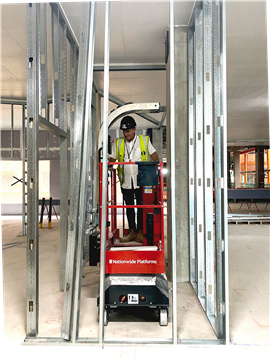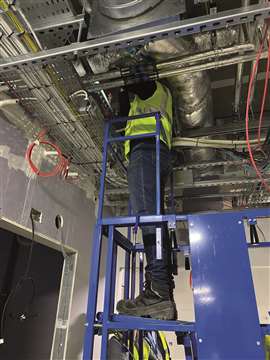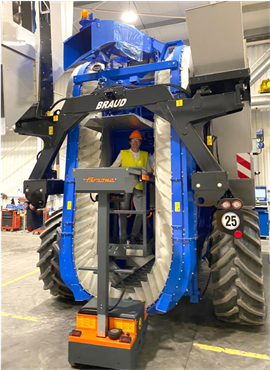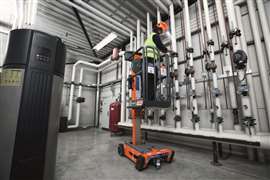Low level access - gaining a high profile
19 August 2024
Low level access is gaining ground as a safer, more efficient solution and being accepted into wider applications, such as in industrial settings
According to Cecilia Lusardi, Sales Area Manager at low level access (LLA) specialist Bravi, the product type is widely surrounded by the misconception that they should be cheap products, just because they work at reduced heights.
“However, if we think about the fact that projects where ceilings that are a maximum 5m high represent the vast majority of jobsites, it is easy to understand how much these kinds of products are actually used.”
The 4.9m Leonardo HD is a classic in the LLA sector, with a working heigh of up to 4.9m. It shares the simple design and user-friendliness of a ladder or scaffold tower but with the comfort and innovation of a self-propelled lift, weighting in at 560kg.
It is the new accessories that are taking it to the next level, according to Lusardi, those being the Solo-Gyps and Small-E.
The Solo-Gyps is a fully motorized electric system activable from onboard the Leonardo HD platform. It simplifies the positioning of panels while cutting in half labour installation costs. With a weight of only 45kg, it can carry panels up to 3650mm long and lift up to 40kg. With four different height positions, it is suitable for taller operators and allows each worker to lift up to 50 plasterboard ceiling panels.
|
Bravi in action From Italian manufacturer Faraone’s point of view, many companies face the challenge of performing maintenance safely and efficiently on machinery in extremely tight and difficult-to-reach spaces. “In facility maintenance, their compact design and easy maneuverability make them ideal for navigating tight corridors and crowded spaces.”  Bravi’s Solo-Gyps and Small-E in action Bravi’s Solo-Gyps and Small-E in action
Manufacturing plants benefit significantly from these solutions for equipment maintenance and inspections. The Elevah ES series is designed to alleviate the issue through their compact bases, offering dimensions ranging from a minimum of 70x98cm to a maximum of 78x153cm. This ensures the equipment can easily navigate through tight spaces. Featuring an extendable basket and near-zero turning radius, the series is also designed to offer maximum maneuverability. The extendable basket and near-zero turning radius further enhances maneuverability, allowing workers to position the lift precisely where it’s needed. 
“This combination of features ensures that maintenance tasks on machines like injection molding presses can be carried out safely and effectively, even in the most confined areas.” The company adds, “There is a clear trend towards replacing traditional ladders, which is why we have introduced the Elevah 40, a self-propelled ground-level platform that reaches a platform height of 2m, providing enhanced safety and comfort compared to traditional ladders.” |
The Small-E is an innovative inspection device created to simplify and improve safety during regular inspections in tight areas located on ceiling surfaces. Easy to add on and remove, with quick release fasteners, it has a weight of 32kg and is conceived with a telescopic design that allows the Small-E to be returned in position when not in use.
A customized and movable top control box comes as a standard with the accessory and can be placed on the extra deck, so that the operator can comfortably drive the MEWP into position while on the Small-E.
Seeing the benefit
From fellow Italian manufacturer Faraone’s point of view, many companies face the challenge of performing maintenance safely and efficiently on machinery in extremely tight and difficult-to-reach spaces.
“In facility maintenance, their compact design and easy maneuverability make them ideal for navigating tight corridors and crowded spaces.”
Manufacturing plants benefit significantly from these solutions for equipment maintenance and inspections.
The Elevah ES series is designed to alleviate the issue through their compact bases, offering dimensions ranging from a minimum of 70cm x 98cm to a maximum of 78cm x 153cm. This ensures the equipment can easily navigate through tight spaces. Featuring an extendable basket and near-zero turning radius, the series is also designed to offer maximum maneuverability.
The extendable basket and near-zero turning radius further enhances maneuverability, allowing workers to position the lift precisely where it’s needed.
“This combination of features ensures that maintenance tasks on machines like injection molding presses can be carried out safely and effectively, even in the most confined areas.”
The company adds, “There is a clear trend towards replacing traditional ladders, which is why we have introduced the Elevah 40, a self-propelled ground-level platform that reaches a platform height of 2m, providing enhanced safety and comfort compared to traditional ladders.”
Industrial expansion
According to JLG’s Power Towers, more customers in industrial settings are realizing the benefits of using low level access in their production and maintenance processes.
“While our solutions are well known in the construction fit-out segment, they are still unknown for use in industrial facilities,” says Richard Puglia, Sales Director, and Jonathan Dawson, managing director, for JLG’s Power Towers.
“
 The Elevah ES demonstrates its compact credentials.
The Elevah ES demonstrates its compact credentials.
We can say that all production facilities are still using traditional mechanical equipment - ladders, podiums and scaffolding - when building large machines in their factories. Depending on the use case, they can quickly see the benefits of our low level access solutions in terms of safety, ergonomics and efficiency.
“We have seen our solutions being used to replace valves, replace cabling and perform required maintenance on elevated conveyer systems.”
The company’s Nano SP+ is often the product of choice in these facilities since it provides an overreach of one meter that allows operators to reach up and over obstacles to perform their work. As far as ladder replacement, customers prefer either the Eco or Pecolift since similar to a ladder, they can be used at any time since they have no electric or hydraulic system.
In addition, the Eco and Pecolift, while requiring a trained and familiarized operator, offer ease of use and efficiency and are instantly deployable. The cost to benefit ratio to help to lower operator risk makes the investment decision almost instantaneous.
 Power Towers Pecolift in another maintenance application
Power Towers Pecolift in another maintenance application
Puglia and Dawson add, “It all starts with safety, but as more operators use our equipment and realize they work more efficiently, in addition to safer, they request to use our products more and more. So, the number of units in one facility quickly multiplies and then makes its way to another facility for the same company in a different location.”
“Operators, like all humans, are wary of change. We need to make sure that our solutions are properly demonstrated, implemented and the operator can be trained in a simple and efficient manner.
“Usually in every factory, you will find early adopters and they need to be nurtured so that they can work with their colleagues to show the benefits of our solutions.”
In operation
As Axolift points put, low level access equipment is generally used when factories are in operation. All three models from Axolift, the Manulift 200/4, the Elift and recently also the P300 are designed to accomodate this situaion.
 The Axo Lift P300 carried out work in industrial maintenance.
The Axo Lift P300 carried out work in industrial maintenance.
Ernst van Hek, business development manager at Axolift, says, “In general we see an increase of demand from construction related industry. Injuries from falling at heights is one of the biggest accident risks on sites, and in most European countries various institutes are addressing this more and more.”
One of the challenges, says van Hek, for the rental industry outside the UK the promotion of low level access is not yet a priority, “We believe this will be changing in time when the demand from the customer rises due to awareness as well as national or regional health and safety authorities becoming more pro-active in promoting the use of safer working methods to prevent falling from heights.”
On the design side, van Hek adds that this equipment must be designed and build with the unique demands the rental industry is expecting. “Equipment is being used on many different locations and by many different users,” van Hek points out. “Cost efficient design and lowest possible cost of ownership are key factors as well. We also see a trend to design low level access equipment for customers outside the rental industry. But in all cases low level access products will become more user friendly and more cost efficient to use and own.”





